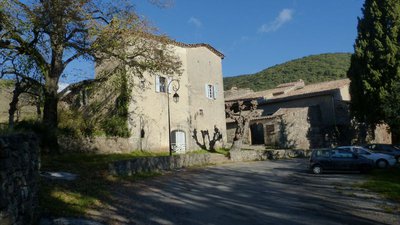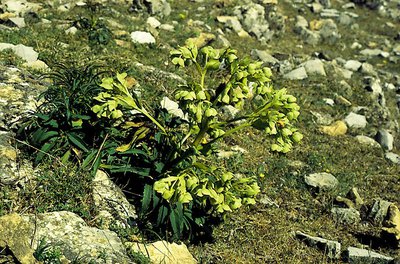
The Puechs
4 points of interest

Le pont des Camisards - nathalie.thomas  History
HistoryThe Pont des Camisards
Legend has it that this humpback bridge was built from 1702 to 1704 by Jean Cavalier, a leader of the Protestant Camisard uprising against the Catholic King. And a legend is all it is. It was constructed a decade later, from 1714 to 1718, when Louis XIV's Intendant, a Monsieur de Basville, decided to develop the road network in the Cevennes. The diocese of Alès was responsible for funding a large share of the construction, and the inhabitants of Mialet were forced to participate through work our paying taxes. In 1976, it became a listed monument. (Nelly Bernard)

Musée du Désert - nathalie.thomas  History
HistoryMas Soubeyran
The idea for a “Museum of the Wilderness” goes back to 1880, when the Société de l'histoire du protestantisme français launched a subscription to buy the birthplace of the Camisard leader Roland (real name: Pierre Laporte). […] In 1910, the Musée du Désert was created as a memorial site to trace the history of Protestantism from 1685 to 1789 and its fight against the French regime's intolerance. […] It is intended to bear witness to the past and promote awareness of the spiritual and cultural heritage that shaped the Cevenol mentality. Every first Sunday in September, almost 20,000 people gather in the shade of the oaks at Mas Soubeyran to hold a Protestant service – the so-called Gathering in the Wilderness. (Nelly Bernard)

Moulin dans le valat de la Baumelle - nathalie.thomas AgricultureMill
Very old mills for producing oil, wool and flour border the Valat de Baumelle gully. Note the mill pond (Occitan: gorga) at the edge of the path and backing onto the mill. The inhabitants of Luziers laid out their vegetable plots on the many terraces you can still see on either side of the path. The uppermost terraces – the “dry gardens” – were reserved for crops needing little water: broad beans, lentils, peas, etc. Other vegetables were planted on terraces that lay closer to the waterway. They were irrigated using a system of terracotta pipes connected to small basins. (Nelly Bernard)

Hellébore fétide - © Yves Maccagno  Flora
FloraHellebore
Alongside the paths grows a plant whose name, at least, is known to all those who remember La Fontaine's fable of the Hare and the Tortoise: “Pray take, your senses to restore / A grain or two of hellebore”. Hellebore, also known as dungwort, is toxic – but it does not cure madness as popular belief had it. This member of the buttercup family is evergreen and can be identified in winter by its pale green leaves, which are spear-shaped and palmately lobed. […] Its pale green flower stalk has bracts and dies after flowering; it appears in February to March. It is embellished with five greenish petals with a red edge and ten petals of a rather unpleasant nectary shape. Shepherds hung it in sheepfolds and used it to treat abscesses and sheep scab. (Nelly Bernard)
Description
Signposts will guide you all along this route. In the description below, the signposted place names and/or directions are given in bold italics between quotation marks:
From the car park "Mialet", turn right onto the D 50, cross the Pont des Camisards bridge.
- At "Pont des Camisards" turn left towards
- "Le Travès". Then head for Mas Soubeyran via:
- " La Rouquette".
- At "Mialet-Mas Soubeyran", take the path on the right to reach La Baumelle gully, which leads to the mas (farm) of the same name. Walk past the mas on its right.
- At "La Baumelle" continue on the track to join up with the road. Turn right onto the road and after 250 m turn left on a path towards La Rouvière.
- At "La Rouvière", turn left onto a fire road (DFCI) and take a path on the left that goes downhill into Roquefeuille gully. Cross the bridge, take the road on the left and then a small path on the right that will lead you back to Mialet.
- Departure : Mialet
- Arrival : Mialet
- Towns crossed : Mialet
Forecast
Altimetric profile
Recommandations
Make sure your equipment is appropriate for the day's weather conditions. Remember that the weather changes quickly in the mountains. Take enough water, wear solid shoes and put on a hat. Please close all gates and barriers after yourself.
Information desks
Tourism office Cévennes Tourisme, Saint-Jean-du-Gard
Maison rouge, 30270 Saint-Jean-du-Gard
This office is part of the National Park's associated tourist-information network, whose mission is to provide information on, and raise awareness of, the sites and events as well as the rules that must be observed in the National Park's central zone.
Open year-round
Access and parking
From Anduze, take the D 129 towards Générargues, then the D 50 to Mialet
Parking :
Calculateur d'itinéraire Lio
Utilisez le calculateur liO pour organiser votre trajet en région Occitanie.
Autres régions
Calculez votre itinéraire en Auvergne Rhône Alpes sur Oùra
Biodiversité autour de l'itinéraire
Source


Report a problem or an error
If you have found an error on this page or if you have noticed any problems during your hike, please report them to us here:

